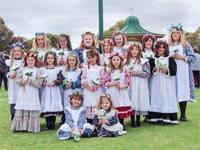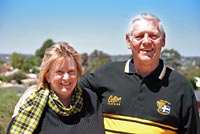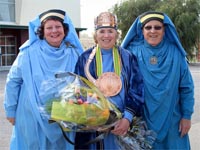2013 Dates
Next Gathering:
Maureen Fuller and Rob Lloyd

Kernewek Lowender Dancers 2013

Maureen Fuller - Grand Bard

Leanne and Rob Lloyd

Libby Luke, Maureen Fuller and Tom
Luke
|
|
From what we can establish the first official
Cornish group in Bendigo was suggested in
November 1891 when a group of people gathered
with the object of forming a branch of the
Cornish Association of Bendigo.
The next mention of a formal group was the
formation of a Cornish Society which was
publicised in The Argus newspaper on 6th May
1913. Mr S. J. Langdon was appointed
secretary pro tem. On 10th June, the same
newspaper reported that “at the meeting of the
Bendigo Cornish Society on Monday night, Sir
John Quick was elected president.”
There are numerous articles which show that this
society functioned quite well up till the late
1920s at least. No doubt the start of the
great depression helped contribute to its
demise.
In more modern times the now defunct Cornish
Association of Bendigo and District was formed
in 1986. As the Bicentennial year of 1988
approached there was a renewed interest in
Genealogy and a large number of people had a
desire to learn more about their Cornish
heritage. This resulted in the formation
of the Cornish Association of Bendigo and
District Inc. It was formed in September
1986 with Edward (Ted) Hocking taking on the
role of President. There is no doubt that
Bendigo has the largest number of Cornish
descendants of any locality in Australia and a
desire by so many to discover their heritage
enabled the Association to survive for over 25
years.
The main aims of this Association were to foster
goodwill amongst people of Cornish descent,
promote the Cornishness of our beautiful city
and to maintain strong ties with Cornwall.
Many plaques have been erected around the city
and surrounds and the Association assisted with
the erection of a wonderful statue to the
Cornish Miner in the heart of the city. As
a noted Cornish born Mayor of the city James
Henry Curnow stated in 1921 to the then Prince
of Wales (Duke of Cornwall) "It was the Cousin
Jacks that made Bendigo" and this tradition has
been followed. The Cornish
Association of Bendigo & District ceased to
exist as a group in September 2011 but that does
not mean that passionate folk here in Bendigo
have not continued to promote, educate and share
their love of all things Cornish and that a
commitment by them to continue to celebrate
strong Cornish ties has abated.
The Bendigo District is somewhat unique in that
it has a Cornish culture of its own. Gold
was discovered in Bendigo late in 1851 and
Cornish miners were amongst those in the first
hectic rush, most at that time, having trekked
across from the copper mine fields of South
Australia. During the 1870s there was a
considerable influx of Cornish miners into
Victoria, many going to the Bendigo and district
mines. As the alluvial gold petered out
and quartz deposits were exploited, the Cornish
experience of metal mining was essential to the
economy of Bendigo.
The Cornish Association has taken part in a
number of Dahlia & Arts festivals, showing
people some of the Cornish contributions to the
area by putting up displays and making members
available to assist people who wish to learn
more about Cornish heritage and history.
Our first Bardic ceremony in Bendigo was held at
a Dahlia & Arts festival and it was the
first time that flower girls and The Lady of
Victoria were part of the ceremony in
Victoria. Bendigo has the distinction of
having seven of its residents being recognised
and honoured by being made Bards of Cornwall for
their contribution to retaining the history and
culture of Cornwall overseas. There are at
least three other Bards of Cornwall who although
they do not currently reside in the area, are
Bendigo born. Five of the Victorian bards
have the word Bendigo in their Bardic name. This
is rather unique for such a small geographical
area and reflects the strong Cornish connections
which still exist in this part of the
world.
There is a well known saying that states: “By
Lan, Car, Ros, Tre, Pol and Pen—ye shall know
most Cornishmen. As Ruth Hopkins pointed
out in her publication “Where Now Cousin Jack”
this saying fails to acknowledge surname
prefixes such as Nan, Che and Chy amongst
others, however, Williams is the most common
Cornish name. The very first Cornish in
Australia were amongst the convicts and settlers
who arrived with the First Fleet in 1788 and
with the subsequent Second and Third Fleets of
1790 and 1791. Indeed, the first person to step
ashore at Sydney Cove in 1788 was the Cornish
convict James Ruse, who later became a farmer at
Parramatta. Amongst those who sailed with the
First Fleet was Lieutenant Philip Gidley King
from Launceston in East Cornwall (Governor of
Australia). A second Cornishman to
rise to high office in Australia in this early
period was Captain William Bligh.
After many years of research Cornish researchers
here in Bendigo have been able to identify over
200 mine managers with Cornish heritage working
in Bendigo and district mines. Names such
as Jewell, Youlden, Grigg, Eddy, Allen,
Bartlett, Bray, Butson, Coakes, Kneebone,
Langdon, Richards, Rickard, Roscrow, Rosewarne,
Rowe, Rogers, Truscott, Veale, Renfrey and
Nankervis to name just a few. There were
many other Cornish folk who made their mark here
in Bendigo. Among them are ‘Jimmy’
Jeffrey who conducted the first religious
service on the Bendigo goldfield. He and
others were strong leaders in the Methodist,
Bible Christian and Wesleyan churches, of which
there were many in the early days of Bendigo’s
history.
Other names which are but a small sample of
Cornish people of note include :
Sir John Quick—often referred to as “One of the
Fathers of Federation’;
V.C. winner Lieutenant W. J. Symons;
William Matthews who was the owner of the
Cornish Store at White Hills;
Henry Hattam, Cornish born Mayor of Bendigo;
John Praed, Mayor of Eaglehawk;
James Scaddan, educated at Eaglehawk—went on to
become Labor Premier of Western Australia;
James Curnow, served for 28 years with five
terms as Mayor of Bendigo.
It is worth noting the following Cornish
connections which often go unrecognised.
David Fletcher Jones who was the founder of the
clothing firm of Fletcher Jones was the son of
Cornish born Sam Jones. This family
arrived in Bendigo in 1852.
Henry Madren Leggo is another person who should
be acknowledged. He began work with Mr. F.
Rickards in 1882, was taken into partnership
with the firm and in 1894 bought out Mr.
Rickards. He began trading as H. M. Leggo
and Co. and the products coming out of his
business included jams, pickles and sauces which
became household names and which are still being
sold—albeit nowadays with an Italian slant!
Another prominent business in Bendigo was Reed
Bros. They were a household name in
Victoria in their day and their products
included sauces, cordials and soft drinks.
Gripe Brothers were in business as timber
merchants in Bendigo.
Other contributors to the building industry in
Bendigo were Walter Meager—a stonemason; William
Caddy—a builder of note; Johns
Brothers—contractors for a number of important
buildings and George Davey J.P. who was another
builder of note.
Blacksmiths and foundry workers including Sam
Jones, Abraham Roberts, George Gripe, Sydney
Osborne, William Mitchell, Holman Bros, W. J.
Dunstan and Thomas Pearce all made valuable
contributions in this field.
John Goyne cornered the market for manufacture
of stamper gratings and Charles Perry, a tailor
originally, began the fuse factory in Wattle
Street.
J.H. Ebbott had a coach building operating in
Long Gully and Thomas Edwards set up a pyrites
works in Clunes before moving to Bendigo in
1871. Other pyrites operators were J.
Frances, Spargo Bros. and J. Deeble.
Mr. Ley Boase set himself up as a draper in Pall
Mall. Part of his store was eventually
acquired by Sydney Myer. J. H. Teague and
James Curnow set themselves up as Estate Agents.
These names are just a small sample of Cornish
folk to whom Bendigo owes homage. There
are many thousands more who helped make Bendigo
what it is today.
Now, after almost two years since the demise of
the Cornish Association of Bendigo and District
we are pleased to announced that a new group has
been established to continue the celebration and
promotion of all things Cornish here in
Bendigo. This group is called “Cornish in
Bendigo” and is a special interest group of the
Cornish Association of Victoria.
Partnering with the main Victorian Cornish group
means that members are part of a larger parent
group with all the benefits of the Victorian
membership, including access to a wonderful
library and research options but still having a
smaller group focus here in Bendigo where we
will be able to meet socially during the year
and assist the CAV with events and functions
held here in Bendigo, including the next Cornish
festival in 2014, which will form part of the
2014 Dahlia and Arts Festival.
|
|
|
|
|
|
|
Images
chosen
by  |
|
|

